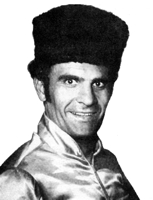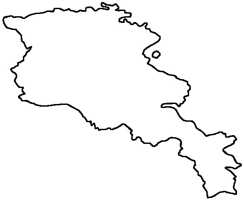
|
The Society of Folk Dance Historians (SFDH)
Armenian Dance
[
Home |
About |
Encyclopedia | CLICK AN IMAGE TO ENLARGE |

|
 In tracing the origin of the various Armenian dance forms, expressions and movements, one should consider very seriously Armenia's subjugation or domination throughout her history and many kingdoms under several major powers, namely and in order: Persian, Greek, Roman and Byzantine, Arab, and finally Turkish. It was through the latter that Armenia gained very little but lost much in life and land plus obstruction of their social, economic, and cultural advancement. However, they clung to their Christian Apostolic faith (they were the first to accept Christianity in 303 CE), plus their language, customs, traditions, ancient rituals, and, according to several Armenian and Greek chroniclers, their ancient folk songs and dances.
In tracing the origin of the various Armenian dance forms, expressions and movements, one should consider very seriously Armenia's subjugation or domination throughout her history and many kingdoms under several major powers, namely and in order: Persian, Greek, Roman and Byzantine, Arab, and finally Turkish. It was through the latter that Armenia gained very little but lost much in life and land plus obstruction of their social, economic, and cultural advancement. However, they clung to their Christian Apostolic faith (they were the first to accept Christianity in 303 CE), plus their language, customs, traditions, ancient rituals, and, according to several Armenian and Greek chroniclers, their ancient folk songs and dances.
As a result of approximately 500 years of Turkish domination, however, and at times, servitude, several things are apparent: many Armenian family names evolved from Turkish roots; names of various foods and other vocabulary have crept into the language. After the 1915 Turkish massacres of the Armenian population of Eastern Turkey, fleeing Armenians took with them to many parts of the world, including Soviet Armenia, their various regional dances but at times with the names of Turkish, Kurdish, and even Arabic derivation. Then, when considering that for centuries, other minor entities took up areas in Eastern Turkish – Circassians, Kurds, Assyrians, Arabs, Chaldeans and Greeks, to name some – it's not difficult to perceive how dance and language was affected and influenced. Armenia became a republic of the Soviet Union in 1920.
The Yerevan Sayat Nova Choreographic School folk dance program is a four year study course leading to a diploma in dance choreography and the certificate "Professional Dancer of the Soviet Union." Students study, besides Armenian folk dance, classical ballet, plus character and international dance forms. Various types of examination is made up of a large concert at the Philharmonic in Yerevan, capital of Soviet Armenia. There are three state dance ensembles (one is both song and dance). Two are located in Yerevan, and the third in Kirvokan, in Northern Armenia.
Many factories throughout the republic sponsor dance organizations, many of the groups of which are quite good. Folk dance throughout the regions is still very much a part of the village environment. Most of the new incoming dancers of the state ensembles are selected and auditioned from the list of graduating students of the Sayat Nova Choreographic School. However, some exceptionally talented factory and even village products have made the grade.
Armenian Folk Dance is divided into two forms: Eastern (or "Kavkaz") Armenian, and Western (or "Anatolyan") Armenian<. And going further, Eastern Armenian is subdivided into three regions, "Leninakan," "Lori," and "Krabakh-Zangezoor." Western Armenia is subdivided into four regions: "Sassoon-Taron," Vaspoorakan," "Shatakh," and "Kareen."
Some important transliterations should be mentioned using the names of Armenian dances and their meanings.
|
APPROXIMATE
a – car
ee – eel O – oats gh – Greek gamma e – ever
oo – oops kh – loch u – us ts – its
|
EXAMPLE
ar – dance
Kafaneets – from Kafan Shoror – smoothly Aghcheekneroo – girl's Bert – fortress
Zoornee Trngee – zoorna plays Papakhnerov – with hats Tughamartneroo – men's Tarontseeneroo – those from Taron |
The final syllable in the above is always stressed.
STEPS AND STYLING
Male arm positions:
- 1st position – Arms extended together straight fwd, palms away
- 2nd position – Arms extended straight to each side, palms away (most popular position)
- 3rd position – Arms curved to overhead pos, fingers touching and palms up
- 4th position – Combination of 2 and 3 with either arm
Female arm positions:
- 1st position – Arms extended fwd together at waist level, palms away, and fingers in "Y" form ("Y" signifies "Yeghneek," an Armenian mountain deer which the formation of fingers symbolizes – middle finger and thumb rounded while other fingers are extended)
- 2nd position – Arms extended to sides
- 3rd position – One arm in front of chest, elbow bent, and other arm extended to side
- 4th position – One hand near side of face, elbow bent (head slightly turned in opposite direction), and other arm raised above head on same side as first hand
IMPORTANT: There are many other arm positions plus movements built around the above.
TERMINOLOGY
|
MUGRAT (scissors): VOT NAZART or SEELLA (Foot in place):
NAZANK (graceful): KERTSEE (feed): TAP (bend): TSAP (clap): TSUNKATSALOOM (squat): JAKHARAK (spinning wheel): YEGHNEEK (deer):
DZERKHA (of hand): MANROOK (small):
SYOOZMA: |
Men's squat-kick-leap across step. Found in "Papakhnerov." Men's in-place step. Found in "Elloo Yar."
Describes movement of Armenian female dancer from all parts of her body. Concerns the several forms of hop-step-steps (found in many of the dances). Any of such type of movements. Found in several dances. In several men's dances. Symbolized in movements of "Aghcheeneroo Par." Women's arm positions.
Turning or movement of women's or men's hands. The many steps described in women's dances or figures.
Kneeling and at the same time describing story action, occurrence, with upper body. |
IMPORTANT WORDS
Some important words on style of both men's and women's Eastern and Western Armenian dances should be mentioned. More solo or "free hands" dancing is found in Estern Armenia. Men utilize erect, upright form, and movements are very bold, clean, and extremely sharp. Men's dances from Western Armenia show more looseness of body. More movement of hips and shoulders are apparent. Vaspurakan line dances of Western Armenia are noted for their uniqueness and complexity of foot patterns and upper body movements. Women's movements, both Eastern and Western, display smoothness, variety of arm, shoulder, hand, and head movements.
Especially significant and apparent is the smoothness of the arms and wrists and the wavy, gliding action of the hands during changes in direction of movement or during transitional periods. In both areas, however, it is not uncommon to see women dancing alongside men in lines with the same aggressive footwork, but at the same time, displaying temperament quite in hand.
DOCUMENTS
- Armenia, a country.
- Armenia and the Armenians, an article.
- Armenian Dance History, an article.
- Armenian Dances, an article.
- Armenian Dancing, an article.
- Armenian Folk Dance Types, an article
- Armenian History and Culture, an article.
- Peoples of the North Caucasus, an article
- Tom Bozigian, an article.
- Transcaucasia, a region.
Used with permission of the author.
Reprinted from the 1974 University of the Pacific (Stockton) Folk Dance Camp syllabus.
This page © 2018 by Ron Houston.
Please do not copy any part of this page without including this copyright notice.
Please do not copy small portions out of context.
Please do not copy large portions without permission from Ron Houston.